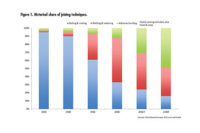The New Century of Adhesives
To answer our questions on the outlook for the industry, we leaned on members of our editorial advisory board and others representing raw material and equipment suppliers, adhesives manufacturing, product development, technical service, business management and consulting.

Tap into the expertise of an impressive group of professionals specializing in adhesives and sealants, ask them to predict the future for the industry, spice it up with their opinions on some hot topics, and you come up with a good read.
To answer our questions on the outlook for the industry, we leaned on members of our editorial advisory board and others representing raw material and equipment suppliers, adhesives manufacturing, product development, technical service, business management and consulting.
Here’s what they told us.
What will be the single biggest trend in the industry and why?
Augustin T. Chen, director, Adhesives & Binders Technology, Solutia, Inc., Springfield, Mass.: I think the environmental issues (such as volatile organic compounds (VOCs), recycling needs and product life-cycle responsibility), whether driven by the government or by the desire of the general population for a greener world, will continue to lead the development of new and emerging new-generation products.
Dave Bongiorni, market development manager, Devcon, Danvers, Mass.: Adhesives that will bond dissimilar substrates. Most applications for adhesives try to replace mechanical methods and fasteners. Substrates involved are dissimilar – urethane to aluminum or PVC to stainless steel. These applications tend to be the toughest for the customers because they have not found reliable answers to their problems.
John M. De Stefano, president and vice president, Hydrocarbon Resin Services, D&A, Inc., and DeWitt & Co., Venice, Fla.: There are two trends, not one:
- Adhesive bonds are stronger now than they were 20 years ago. They will continue to get stronger and bond to new substrates with unclean, uneven and defective surfaces.
- Adhesive bonds are emphatically over-engineered for most applications. That will open the door to more economical adhesive systems where the bond is engineered to a factor of 1.05, or 5% greater than what is needed. I believe that our scientists will become so capable that they can easily define what the requirements will be for most high-volume applications. The trick will be to keep the adhesives consistently reliable.
George Ritter, principal engineer, Edison Welding Institute, Columbus, Ohio: The biggest single trend will be the decreased use of solventborne adhesives and the increased use of 100%-solids adhesives, possibly even at the expense of waterborne adhesives. The drivers will be increased costs for waste disposal or emissions and increased cost for energy used in processing.
Jeff Timm, business manager, Adhesives, Johnson Polymer, Sturtevant, Wis.: The single biggest trend in the industry is supply-chain management and all the things associated with that discipline. Areas like pricing, inventory levels, single vs. multiple source, limiting supplier base and Internet ordering will play a part.
David Kirsch, manager, ConProTec, Salem, N.H.: The single biggest trend in the adhesives industry is an increased use of two-part epoxies, urethanes, acrylics and silicones. One reason for this growth is the improvement and simplification of handheld cartridge dispensing systems. Disposable-plastic static mixers make up a significant portion of these systems. These mixers provide inexpensive point-of-application metering and reduce material waste. The advent of these systems has made two-part adhesives as easy to use as single-component adhesives. Two-component adhesives can be tailored to specific applications and are typically superior to single-component adhesives.
Gary F. Scheeser, manager, Product Development and Technical Service, Neville Chemical Co., and Martin Stumpf, consultant to Neville Chemical Co., Pittsburgh: The industry trend continues in the direction of reactive adhesives. Demand will be for shorter cure times and improved bonding to low-energy surfaces with thinner films.
William E. Broxterman, president; Roger Lohman, vice president; and Robert W. Smith, director new-business development, The ChemQuest Group, Inc., Cincinnati: We see two important trends – consolidation and globalization. The consolidation is occurring not only within the ranks of adhesive formulators but also among raw-material suppliers and end users. Globalization has already occurred in the diaper market and is extending to the automotive market, and others.
What do you see as the biggest challenges for the industry? Opportunities?
Chen: I think the industry has done a good job on VOC reduction. However, I also think the adhesives industry still has a lot to learn on the “stickies” issue that is challenging the paper-recycling industry. Furthermore, more restriction on PVC will require the industry to develop more products that are designed for substrates with lower surface energy, such as polyolefins.
These challenges can also lead to opportunities for those who recognize the needs and develop the new generation of products to meet these needs.
Bongiorni: Ensuring that adhesives are “easy to use” for the customer. I also see our customers making sure that all products meet the regulatory requirements of the industry. Opportunities include the ability to bond composites/plastics for long-term impact and durability.
De Stefano: Developing new polymers for hot melt and water-based applications. Secondary to that is the need for better dispensing and drying equipment, i.e., less quantity applied at higher speeds.
Ritter: The biggest challenge for the industry will be the cost and justification of R&D to provide genuine advances in technology. Somebody has to pay for R&D and that somebody is the customer. They don’t want to. Without that distributed risk, adhesives companies cannot be expected to make leaps in technology. We’re already seeing it in aerospace and automotive. When you want it and it isn’t there, don’t come crying to us.
The biggest opportunity is in technical support at the local level. This may well fall on the local representative. The manufacturing industry is moving to smaller and smaller businesses that don’t receive technical support from the major producers for economic reasons. This places the burden of tech support increasingly on rep firms that aren’t really designed to handle it. A part of lackluster growth in adhesives use is no technical support for potential applications by small companies. Inches make miles.
Timm: Applications are getting more refined and niched. However, customers are unwilling to pay for smaller batch sizes and research sometimes necessary to develop the niche products. This is causing a re-examination at what an acceptable margin is and what one is willing to do to “get the order.”
Kirsch: The adhesives industry is experiencing a shift toward the impersonal and inert. The current trend toward mergers and acquisitions is breaking down communication between the large adhesives manufacturers and their ultimate customers, the end users. As companies become more impersonal, they compromise their ability to react and adapt to the needs of small- and mid-sized companies. This leaves a vacuum in which new adhesives manufacturers grow. The new formulators develop until they are large enough to attract the notice of larger companies, at which point they are assimilated, beginning the cycle anew.
Additionally, current trends in communication technologies present a double-edged sword. Voice mail and e-mail are, if used correctly, powerful tools for improving communication. However, if used incorrectly, these tools can discourage it. I see the biggest challenges to the industry in maximizing the positive attributes of communication technology while minimizing the negative attributes of less person-to-person contact.
Scheeser/Stumpf: In general, the biggest challenge for the industry, including suppliers, will be improved performance and cost-efficient products. Some challenging areas in particular are the replacement of mechanical fasteners with adhesives for automotive and heavy industrial assembly. Also, there is a need in the area of reactive adhesives for less-energy-consuming UV and EB products. We like to think that a great opportunity is a highly responsive user with a willingness to try something new.
ChemQuest Group: Biggest challenge — Maintaining profitability in a maturing industry. As an industry matures, leverage always moves downstream toward the ultimate end user. Those who survive and prosper will be those who understand where they are in the value chain and know how to create and extract more value within it.
Biggest opportunity — During this consolidation phase of the industry, there is a unique opportunity to build market-leadership positions in specific market segments in which the acquiring company has core competencies.
Which chemistries or technologies will have an impact on the industry?
Roger Shamel, president, Consulting Resources Corp., Lexington, Mass.: There are a number of biotechnologically derived products in the pipeline, including a water-resistant adhesive. Mussels secrete a protein-based adhesive that is more of an annoyance than an asset right now. It adheres to ship hulls tenaciously, roughing up the surface and affecting fuel efficiency. However, this material is several times stronger than epoxy and highly water resistant. If this material could be biosynthesized in the laboratory, it might be an effective dental adhesive.
Chen: Urethane chemistry and UV/EB-cure technology will probably have the largest impact on the near future of the adhesives industry.
Bongiorni: Epoxies and methacrylates. De Stefano: New polymers made with metallocene catalysts for special-purpose uses.
Ritter: The biggest impact in chemistry will probably occur in acrylics and urethanes. I trace this directly to the increased use of plastics and difficult-to-bond materials. Rapid-curing systems, particularly UV-curing, hot melts and other 100%-solids technologies, will play increasing roles.
For significantly increased use of structural adhesives in automotive and aerospace, the enabling technology will be nondestructive testing (NDT) techniques for determining the quality of an adhesive bond. People will not build what they cannot trust to stay together. Applied NDT techniques are needed to verify the integrity of structural bonds during and after the manufacturing process.
Timm: There have really been no new chemistries in the adhesives industry in over 10 years. We still see articles about UV-, EB- and moisture-cure hot melts, touting them as “new” technologies when in fact each is over 10 years old. The same technologies that are present today will be present in the next five years. Conversion away from solvent to water and higher solids has already occurred or at least slowed.
Scheeser/Stumpf: Reactive systems such as urethane and acrylics. UV-cure and improved water-based products will have an impact on the industry.
ChemQuest Group: Waterborne adhesives will always dominate the industry, but solventless reactive systems will continue to enjoy exceptional growth.
Do you predict the industry growth to continue at its current rate (a little better than the GDP), increase or decrease, and why?
Chen: The adhesive products, whether they are used on label/ graphic, automotive, tape, etc., are all highly influenced by living standards. Our world as a whole continues to improve on this. That is why the highest growth rate right now for adhesives is in the developing countries. Since there are many countries that continue to improve their living standard or per capita income, I believe the adhesives industry will continue to grow faster than the GDP.
Bongiorni: As you see from the last several weeks of financial reports, durable goods are up! Companies are growing and they are looking for ways to become more profitable. Adhesives help to solve problems where mechanical methods are currently used. Adhesives companies will be “problem solvers” for their customers.
De Stefano: Yes, I expect the industry will continue to grow at its current rate because adhesives replace so many techniques and products used to assemble items, i.e., rope, staples, paper clips, nails, welds, nuts and bolts, etc.
Ritter: Growth will be found in manufacturing related to plastics and in genuine structural bonding for automotive applications, particularly those using aluminum or thermoplastics. There will be growth in electronics manufacturing, but only a few domestic suppliers who already cater to that market will enjoy it. They will be fighting increased competition from foreign suppliers.
Timm: Same rate until we discover a new application platform, i.e., structural pressure sensitive adhesives, replacement for welding. Stronger growth in Asia than the last few years. Growth in all things disposable, which is a strong application area for adhesives.
Scheeser/Stumpf: New uses for adhesives will aid in keeping the industry growth at its current (better than GDP) rate.
ChemQuest Group: We expect the industry to continue to grow at rates above GDP, but the growth rate is slowly moving toward that of GDP as the industry approaches maturity. There is a continuing evolution of new adhesive applications that emerge every year, but they are being offset by more efficient use of adhesives in existing applications.
Do you think the current trend toward mergers and acquisitions will continue? What effect will they have on the industry?
Chen: For all industries, not just the adhesives industry, what the mergers and acquisitions bring are the critical mass and efficiency that allow them to operate at lower cost and afford opportunity to carry out more development. Before this trend reaches the point where monopoly becomes an issue, I expect to see more mergers and acquisitions to occur.
Bongiorni: As long as smaller players in the market feel their technology will grow if they join forces with larger adhesives companies, yes, the trend will continue. The smaller company benefits from the merger by using the larger company’s name, influence and marketing skills. The larger company may gain new and unique technology to their market. It is a “win-win” situation for both.
De Stefano: Yes, with the leaders like National Starch paving the way. National, however, is only following the multinational firms like Proctor & Gamble. The trend will be toward global standards for polymers, tackifiers, etc. What this will do is make the developed-world business more prosperous and open up joint-venture opportunities for the developing countries.
Ritter: Mergers and acquisitions will continue, and overall product offerings will decrease to streamline the marketplace. Ironically, niche markets will continue to intensify with more and more conglomerates needing to implement horizontal diversification of profit-and-loss control into effectively small business units. The biggest advantage of consolidation has been the elimination of redundant product lines and focus on market strengths.
Timm: Merger and acquisition (M&A) activity will continue as long as the economy stays robust. The effect on the industry is a decrease in technical innovation since most M&A activity is to lower cost and homogenize the distinct differences and competitive balance between the two merging companies. Taking risks is usually not done in times of reorganization or restructuring. Most of the reduced staffs are fighting to keep their jobs. Therefore, most work activity tends to be tactical and conservative, and the mindset is to not “rock the boat.” Most R&D effort in M&A situations tends to be tactical because long-range research costs money. No one is usually willing to try the new experiment or take a risk if his or her career is on the line.
Scheeser/Stumpf: The current trend towards mergers and acquisitions will continue, but perhaps at a slower rate. This leads to a more-efficient industry.
ChemQuest Group: The continuing trend toward acquisitions and mergers is absolutely certain. These companies will be able to benefit from economies of scale and other synergies to lower their cost of business. This will, in turn, make it more difficult for conventional, smaller companies to show an acceptable profit.
Do you think that packaging will continue to be the biggest market for adhesives? Which markets do you think will advance and decline?
Chen: I think anything related directly to the promotion of consumer products will grow fast. Again, this relates to people with higher living standards purchasing more than their basic needs. Therefore, the attractiveness other than the basic need will be the main promotion. Packaging is a good example. However, the graphic advertising film/label for other nonpackaging applications, such as building windows, transportation, tools, etc., will continue to capture share from other market segments.
Bongiorni: Automotive will increase, as it is always looking at applications for its long-term projects. The tooling market will decrease.
De Stefano: Probably, because of the ease of unitized shipping containers and speed of product transfer through conventional channels like UPS. The declining segment may be in shoes or clothing as other methods prove less expensive.
Ritter: Packaging will always be a significant opportunity for adhesives because adhesives bonding is the best method for joining large areas of material economically. However, there may be advances in co-extrusion techniques or specialty coatings that will simplify packaging structures and reduce the number of adhesive laminations. In the packaging field, probably medical and high-end convenience-food packaging will increase most. Recyclability will be a major issue in adhesives use for all packaging.
Pressure sensitives in support of computer manufacturing or printing will increase. Automotive will increase. DIY/home improvement/construction will also increase.
Timm: Packaging will stay the largest with disposable, industrial tape and labels growing rapidly.
Scheeser/Stumpf: Packaging will continue as the largest market for adhesives. The market for construction adhesives should advance as adhesives continue to replace mechanical fasteners. Solvent-based adhesives in this area will decline at the expense of water-based products and newer reactive urethanes.
ChemQuest Group: If measured on a weight basis, the packaging industry will continue to be the largest market sector within the industry. However, when measured on a value basis, the product-assembly market will clearly emerge as the largest since this is one of the sectors that is showing the largest number of new applications. It is also the sector that is continuing to capture market share from mechanical fasteners.
We also believe that the automotive industry promises high growth for adhesives in niche areas. The engineered-wood market is also one that is continuing to show above-average growth due to the lack of availability of natural hardwoods.
Which geographical areas do you see expanding?
Chen: The fastest growth definitely will be from the developing countries. Now that the Asia Pacific region has begun to recover from its economic crisis, I believe it will have the fastest growth. In the next decade, South America has the potential to follow.
Bongiorni: All our markets are expanding in all areas throughout the world.
De Stefano: The underdeveloped countries: China first, followed by smaller countries in Asia; the Middle Eastern countries led by Iran; and the trailing region, Latin America.
Ritter: The top five regional areas for increase are China, China, China, South America (especially Brazil) and Africa (if they ever settle down and get to business). The competition will be fierce and international. It will require a strong local commitment and presence.
Timm: Asia will rebound to pre-1995 levels. Fundamental changes in China will occur as it is accepted into the World Trade Organization, i.e., tariff reduction for chemicals, increased indirect sales activity, foreign insurance firms being allowed in China within one year.
Scheeser/Stumpf: Major geographical areas of expansion will be Asia (mainly China), Eastern Europe and parts of the Middle East.
ChemQuest Group: The emerging markets in the Far East will certainly grow faster than the United States and Euroland, but most of this growth will be in commodity adhesives.
What effect will environmental and other governmental regulations have on the industry?
Chen: It has been clearly demonstrated that governmental regulation and environmental policy can dictate the new direction of the manufacturing industry. The VOC issue is a very good example.
Bongiorni: These regulations will help to make the use of all adhesives safe for the industrial workplace.
De Stefano: The world will tend to follow the template of the developed countries in wanting cleaner air and water. The developing countries will conform as they can afford to make these changes.
Ritter: Which is worse: pain or the fear of pain? So far, in the adhesives industry, it has been the pain, which hasn’t been all that bad. Our biggest single casualty has been the loss of chlorinated solvents.
Only a handful of states have really clamped down on solventborne adhesives. Governments have consistently lumped adhesives with paints and coatings for regulatory purposes. Our industry has done a credible job offering low-VOC alternatives where needed. Much of that technology is in search of more sales. Some adhesives suppliers would welcome tighter regulations and enforcement of VOCs to increase plant utilization for their waterbornes or in pushing their customers into 100%-solids adhesives.
When the government really tightens regulations on hazardous-waste generation, it will be awesome, especially in structural adhesives. Here, the government lumps us with the chemical process industries as a “generator.” Look at what it takes to ship a pint of something with a 3-hazard rating, much less dispose of it. That should be “fear of pain,” and it’s been around for a while. The time to think about “green” structural adhesives is now.
Timm: Overall, less of an effect than within the past 10 years. In fact, in some industries, namely the flexible-packaging industry, successful negotiation has occurred with the EPA on Clean Air Act issues, resulting in less-severe rules-implementation regulation.
Scheeser/Stumpf: Environmental and governmental regulations reduce product flexibility and production efficiencies, and increase costs. The regulations do, however, prompt responsible action by industry. On the positive side is industry’s public commitment with the Chemical Manufacturers Association’s Responsible Care® initiatives.
ChemQuest Group: Government regulations will continue to put pressure on solventborne adhesives, but even more pressure on hazardous waste.
Any further comments?
Timm: The industry needs to address the lack of women and minorities in management and key staff positions.
ChemQuest Group: Adhesives have generally benefited from the fact that few applications find the adhesive to be as much as one percent of the final product cost. Therefore, cost-cutting efforts within large companies attack many other sources of cost before the adhesive is considered. In fact, an adhesive is often considered to be a cost-cutting solution when it is able to displace a mechanical fastener.
Scheeser/Stumpf: The adhesives industry is healthy. It has come a long way over the past few decades in terms of efficiency of operations, concern for environment, sound use of technology, strong marketing and recognizing customer needs.
Looking for a reprint of this article?
From high-res PDFs to custom plaques, order your copy today!





